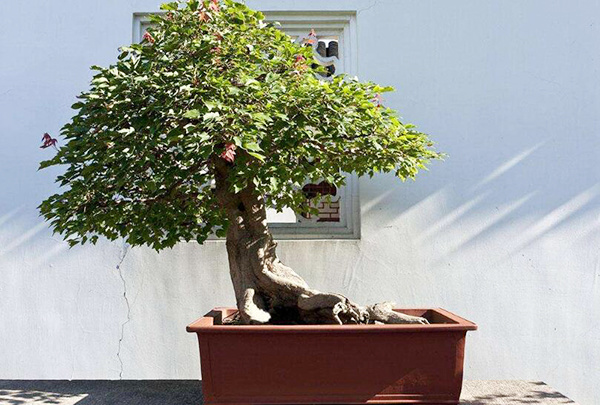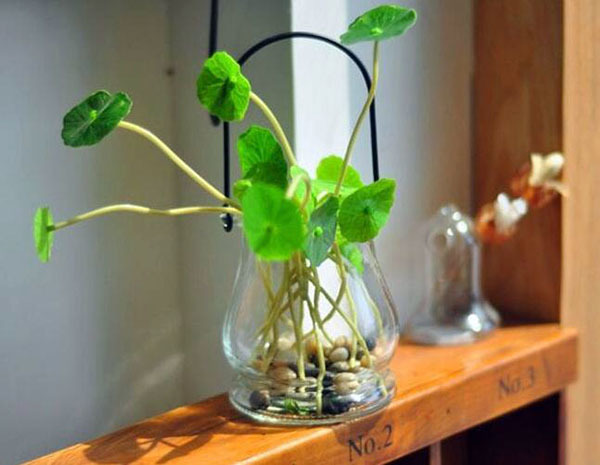The method of making bonsai of Acer truncatum

1. According to the modeling needs of the triangular maple, cut off the unnecessary branches and trim the roots properly at the same time, cut them back after survival in the second year, climb and bend with the wire, keep the branches for 2-4 months, and the branches are basically shaped, and the wire can be removed.
2. In 2-4 years, the top branch should be cut off in the growing season, and the lower branch should be climbed into the desired form in time, combined with stocking and binding branches. Cut 2-3 times a year, so that after several times, it can be basically shaped, and after it is dug up in February-March of the year before the basin, the long root affecting the basin will be truncated to just touch the basin surface, and then planted in the field to grow, a year later. New roots are sprouted at the broken roots and put on the basin, which is easier to survive.
Triangular maple bonsai making course, triangular maple bonsai picture collection
☂☂☂ more home plants bonsai ☂☂☂
→ relieves eye fatigue and green asparagus bonsai
How tiny is the miniature bonsai production of →?
Acer triangulata, also known as Acer, is a deciduous tree of the genus Acer in the Aceraceae family. It is a common natural plant in our life. Today, some people find that the bonsai made with it is very delicate and beautiful, so they immediately like it, and the bonsai made by it is naturally triangular maple bonsai. This has aroused the curiosity of many friends, how is the triangular maple bonsai made, and is the effect of the bonsai good? Next, let's take a look at the Triangle Maple Bonsai making tutorial.
Brief introduction of Triangle Maple Bonsai
Triangular maple bonsai, in short, is a kind of plant bonsai made of triangular maple, which is quite common in our life. Triangular maple is originally a very beautiful deciduous tree, which is called duck palm tree in our daily life, which is very common. Some people like triangular maple to make it into bonsai, but the bonsai has an unexpected effect. Bonsai is full of buds in early spring and looks attractive, while it is green and green at the height of summer, which makes people nostalgic, and the ornamental value is very high.
(picture 1 of bonsai pictures of triangular maple)
Bonsai production of Maple Triangle Maple
As a kind of plant bonsai, the production method of triangular maple bonsai is not difficult, because the production method of bonsai is similar to that of most flowers and trees, so what is the specific production method?
1. Mining routines: the materials that need to be verified first in making bonsai can be dug in the woods of nature. Pay attention to the fact that the roots must be cut in place in one step, and some sprouting branches are reserved above the excavated maple.
2, soil cultivation: newly dug triangle maple can not be used to make bonsai immediately, it needs a meal of maintenance and cultivation.
(picture 2 of Triangle Maple Bonsai)
3, transplant on the pot: wait for the triangle maple to grow to the second year or the third year when you can go on the basin, it is best to choose the spring from February to March, this is the best good time. When putting on the basin, choose the rich rotten leaf soil which is loose and breathable and rich in humus.
4, trimming modeling: after the triangular maple is planted in the pot for a period of time, it can be trimmed and styled properly. Because the dry cleaning of plants is more robust and developed, it is better to choose infarct or stone-attached type. Styling should be based on pruning and proper pruning, and because the plant branches are brittle and hard, the action should be light when flat binding.
(picture 3 of Triangle Maple Bonsai)
A complete collection of bonsai pictures of Maple Maple
Triangular maple bonsai is a kind of plant bonsai with high ornamental value, and its biggest feature is that plants can exude different charm with the changes of the four seasons. In spring, the leaves of triangular maple bonsai are red, looking very human; but in summer, the leaves of plants turn to green, lush, very green; in autumn, the leaves change from green to yellow, fluttering, very elegant; in winter, the leaves fall along with them, looking very elegant and noble, making people have to love them.
(picture 4 of Triangle Maple Bonsai)
Conclusion: triangular maple bonsai is indeed a very rare plant bonsai, but it still needs people's fine care to exude unlimited natural charm, so we must take good care of a triangular maple bonsai at home.
What are the key points of triangular maple bonsai bonsai? Bonsai bonsai technology of Acer truncatum
The deciduous tree of Acer truncatum, up to 30 meters high, can be planted alone or in clusters on grasslands, or mixed with other trees on hillsides and poolsides, and can be planted as shade trees in gardens in China. Because of its unique ornamental value, the cultivation of triangular maple bonsai is gradually favored by people, such as triangular maple, red maple and so on, so today the editor will talk about the bonsai bonsai technology.
The main results are as follows: (1) transplanting: the young trees of Acer truncatum with strong growth and no diseases and insect pests are selected as transplanting seedlings, the seedling height of young trees should not exceed 60cm, and the transplanting time should be in late winter or early spring.
(2) the production of bonsai cultivation soil: choose an open pot container and lay the bottom of the container with a mixture of perlite, river sand, peat and rice husk with a height of 1. 4. After laying, it is covered with a layer of fallen leaf debris and rotten leaf soil, and then covered with a plastic film with air holes. Apply base fertilizer to the film and cover the mixture of mountain mud, pond mud and sorghum shell to the height of the container. Then seal the container with a wooden lid, put it in the refrigerator at minus 5 degrees to 0 degrees, prevent for 2-3 hours, then take out and place at room temperature for use. (the mass ratio of perlite, river sand, peat and rice husk is 1: 4: 1: 3; the mass ratio of deciduous leaf debris to rotten leaf soil is 1: 1: 3; the mass ratio of mountain mud, pond mud and sorghum shell is 2:2:1. The base fertilizer consists of 25% soybean fertilizer, 30% green fertilizer, 20% nitrogen, phosphorus and potassium compound fertilizer, 15% cooked feces, 3% trace elements, 1% microbial fermentative bacteria and surplus eggshell powder; trace elements are a mixture of iron, calcium, cobalt, zinc and selenium with a mass ratio of 1 to 1; and the humidity of mountain mud and pond mud is 45%.
(3) pot treatment: the bonsai cultivation soil prepared in step (2) was filled with moist river sand mixed with dwarf, paclobutrazol and coconut shell activated carbon to 5cm along the mouth of the basin, and the bonsai cultivation soil was disinfected one day before planting, and the planting time was 2 months. Prune the branches and roots of the seedlings before planting, and pour enough water after planting to keep the surface soil moist.
(4) pruning by stages: young plants should be topped and heart-picked, so as to promote the growth of lateral branches. In early summer, cut off the main trunk of 1Compact 3 and prune the branches when they grow more than 20cm. After pruning, plant growth retarders should be applied to the wound. At the same time, it is necessary to prune the trailing branches in time to keep them tall and beautiful, dense and dense. (in which the plant growth retarder is 0. 3% butyrylhydrazide and hydrogen peroxide with a mass ratio of 2:5).
(5) Fertilizer and water management: Acer truncatum potted plants should be watered frequently to keep the potted soil moist. At the same time, organic fertilizer was applied once before sprouting in spring and before leaf spreading, no fertilizer was applied in autumn, and liquid compound fertilizer was applied once in winter. Among them, 2% trace elements are added to the liquid organic fertilizer, and the content of nitrogen, phosphorus and potassium compound fertilizer in the liquid compound fertilizer is not less than 30%. ).
(6) temperature and light management: the suitable temperature for potted growth of Maple Triangulata is 30 degrees, with full sunshine in winter and half sunshine in summer.
- Prev

How to prune and maintain the triangular maple bonsai
How to cut and raise the triangular maple bonsai under normal circumstances, the branches of the triangular maple will be about one meter long in late May, and the branches will be fixed in shape at this time, because the growth rate of the triangular maple itself is relatively fast, so its branches will grow straight up.
- Next

How do hydroponic plants grow fast
First of all, the root, find less water to add some water, to prevent the root system from drying; when the water becomes dirty, take out the plant, clean the container, re-irrigate. Generally, hydroponic plants change water and apply nutrient solution about once a week. The proportion and number of nutrient solution depend on the size of the plant.
Related
- Fuxing push coffee new agricultural production and marketing class: lack of small-scale processing plants
- Jujube rice field leisure farm deep ploughing Yilan for five years to create a space for organic food and play
- Nongyu Farm-A trial of organic papaya for brave women with advanced technology
- Four points for attention in the prevention and control of diseases and insect pests of edible fungi
- How to add nutrient solution to Edible Fungi
- Is there any good way to control edible fungus mites?
- Open Inoculation Technology of Edible Fungi
- Is there any clever way to use fertilizer for edible fungus in winter?
- What agents are used to kill the pathogens of edible fungi in the mushroom shed?
- Rapid drying of Edible Fungi

